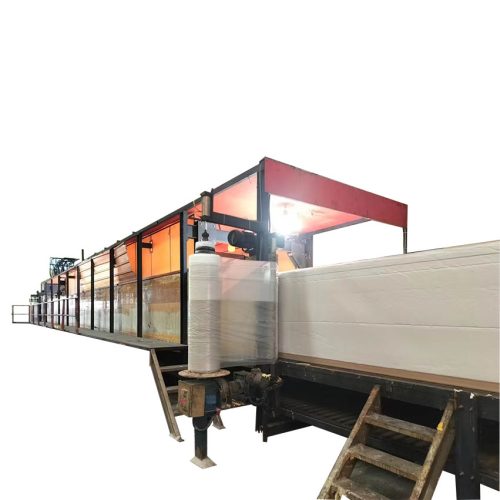- 1. Fundamental Reactions
The formation of polyurethane soft foam encompasses two primary reactions: the foaming reaction and the polymerization (gel) reaction.
Foaming Reaction: Isocyanate reacts with water to yield disubstituted urea and carbon dioxide. The reaction equation is:
2R-N=C=O + HOH → R-NH-CO-NH-R + CO2↑
The CO₂ generated acts as the nucleating agent, causing the mixture to expand and form an open-cell foam structure.
Polymerization Reaction: Hydroxyl groups in polyether react with isocyanate to gradually form urethane. The reaction equation is:
R=N=C=O + R′-OH → R-NH-COO—R′
- 2. Polyols
In domestic foam block production, tri-functional polyether polyols with a molecular weight of 3000 (hydroxyl value 56) or 3500 (hydroxyl value 48, less common) are used.
- 3. Polyisocyanates
The primary polyisocyanate used is toluene diisocyanate (TDI), available in three main industrial variants: pure 2,4-TDI (or TDI100), TDI80/20, and TDI65/35. TDI80/20 is the most cost-effective and widely used variant.
The molecular weight of TDI is 174, with the two isocyanate groups (-N=C=O) accounting for a molecular weight of 84, thus making the isocyanate content in TDI 48.28%.
The TDI amount significantly affects foam properties, with its excess expressed as the isocyanate index, the ratio of actual to theoretical quantity. In soft foam production, the index typically ranges from 105-115 (where 100 equals the theoretical amount). Within this range, increasing the TDI index raises foam hardness, while reducing tear strength, tensile strength, and elongation at break. Excessively high TDI indices can result in large cells, closed cells, prolonged curing times, and foam scorching, while low indices can cause cracking, poor resilience, low strength, and high compression set.
- 4. Blowing Agents
The main blowing agent is CO₂ produced from the reaction of water with TDI. Increasing water content in the formulation raises urea content, foam hardness, and reduces foam density and load-bearing capacity. However, this reaction generates significant heat, and excessive water can cause foam scorching or combustion.
Methylene chloride is a physical blowing agent with a boiling point of 39.8°C. It vaporizes during foaming, reducing foam density and hardness. The amount of methylene chloride added must be balanced to prevent scorching and ensure proper foam curing without adversely affecting foam properties.
- 5. Catalysts
Catalysts regulate the speeds of the foaming and gel reactions to maintain a balance.
Triethylenediamine (A33): This is a crucial tertiary amine catalyst in soft foam production, 60% effective for the foaming reaction and 40% for the gel reaction.
Bis(2,2-dimethylaminoethyl) ether (A-1): A general-purpose tertiary amine catalyst, 80% effective for foaming and 20% for gel reactions, often used with triethylenediamine.
Improper catalyst use can significantly impact the product. Excessive amine catalysts can shorten reaction times, rapidly increase initial viscosity, and cause excessive smoking during foaming, leading to foam cracking. Insufficient amine catalysts can slow the reaction, affecting foam height.
Stannous Octoate: The most commonly used organotin catalyst, which easily hydrolyzes and oxidizes in polyether mixtures containing water and tertiary amine catalysts. Lower foam density narrows the adjustable range for stannous octoate. Insufficient amounts can cause foam cracking, while excessive amounts increase viscosity rapidly, causing closed cells and skin formation.
- 6. Foam Stabilizers (Silicone Oils)
Foam stabilizers lower the surface tension of the mixture, stabilizing bubbles, preventing collapse, and controlling cell size and uniformity. Increasing silicone oil from the minimum to an appropriate amount yields well-opened foam. Excessive amounts increase closed-cell rates.
- 7. Other Influencing Factors
Beyond formulation, process parameters, and environmental factors also impact foam properties.
Raw Material Temperature: Within a normal ambient temperature range (20-28°C), raw materials should be maintained at 25±3°C, ideally within ±1°C. Some control within 28-30°C.
Temperature Effects: Increases in temperature affect foaming and gel reactions differently, with greater increases in polymerization reactions. Catalysts must be adjusted for temperature changes.
Altitude: Foam density also varies with altitude, being noticeably lower in high-altitude areas.

